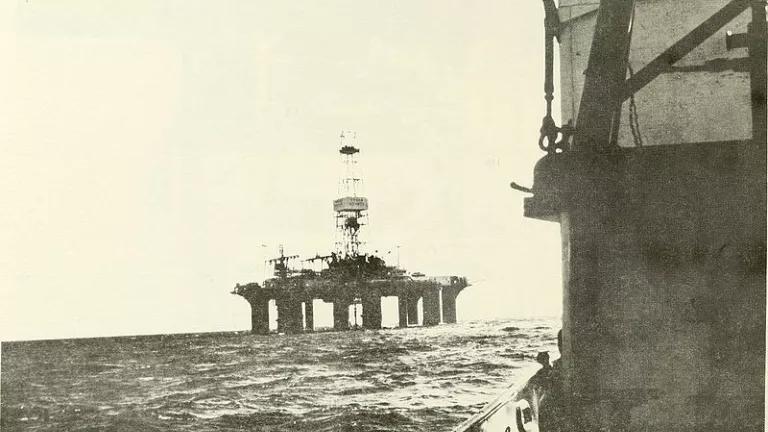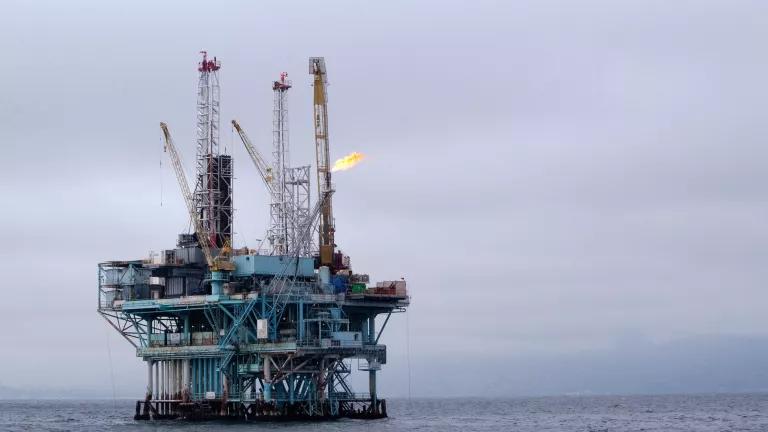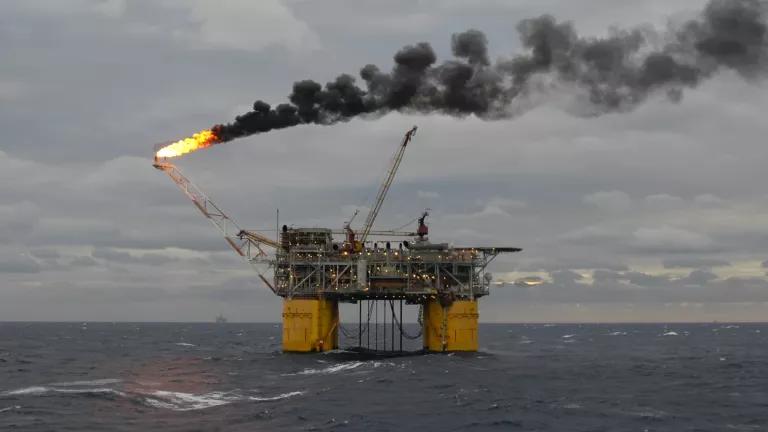Time for U.S. to Kick the Habit of Offshore Drilling
The Biden administration prepares a new five-year plan to lease ocean areas to fossil fuel companies for profit, and business as usual is not an option.

Gales, R. S; Naval Ocean Systems Center (U.S.); United States. Bureau of Land Management 1982
As temperatures continue to break records and our coastal communities shelter from hurricanes, we are facing the very real ramifications of our dependence on the fossil fuel industry. This year the U.S. set a new record for the number of billion dollar climate disasters - which is to say we are facing the consequences now. Meanwhile, the Biden administration is preparing to propose its plan for the next five years of offshore oil and gas leasing in the coming weeks. This new program could release anywhere from the same amount of carbon emissions as the Willow project to 10 times more, according to the federal government’s own projections.
There have been ten five-year programs since the modern offshore leasing framework was established in the late 1970s. Each program includes a proposed schedule of offshore oil and gas lease sales for the coming five years. The schedule sets out when and where each proposed lease sale will be held. After the program is finalized, the government may not hold any offshore oil and gas lease sales that are not included in the schedule, without going back and creating a whole new five-year program. However, the government has full discretion to cancel–or simply not hold–any of the proposed lease sales scheduled in the program.
The decision today about the future of offshore leasing is nothing like a decision 40 years ago. If there was any rationale then for punting or buying time on climate impacts, that ship has sailed. It’s clear that a business as usual offshore oil and gas leasing plan in 2023 is dangerously out of sync with the action needed to address the climate crisis. More leasing also means more pollution in our air and waters and puts our coasts, communities, and marine life at risk of another major oil spill.
Let’s look back through history to better understand how we got here:
1953 - Congress first passed the Outer Continental Shelf Lands Act (OCSLA). The law requires the creation of an offshore and oil gas leasing plan to “best meet national energy needs for the five-year period following its approval or reapproval.” The law was subsequently amended to what we know today.
1989 - the Exxon Valdez oil spill devastated the Gulf of Alaska as the largest oil spill in U.S. waters at the time and led to the 1990 Oil Pollution Act. The tanker that caused the spill was carrying oil from Prudhoe Bay Alaska.
2002 - President George W. Bush submitted a 5 year plan proposing 20 lease sales. Fifteen of those were held and the country leased over 20 million acres to the oil and gas industry.
2006 - The Gulf of Mexico Energy Security Act of 2006 directed the leasing of certain regions of the Gulf of Mexico for oil and gas exploration and production but placed a moratorium on leasing for the Eastern Gulf of Mexico region. It also created a mechanism for sharing revenues from leasing. Revenue sharing from fossil fuel extraction only incentivizes the exploitative and destructive production of fossil fuels on federal lands and waters, and creates a dangerous dependency cycle, even when linked to otherwise potentially positive outcomes.
2007 - Presidents Bush and Obama developed the next plan, covering 2007-2012, listing 16 lease sales (and holding 11) that leased almost 22 million acres.
2008 - Congress removed a ban on leasing and related activities in certain regions of the Outer Continental Shelf. The ban was originally established in Interior appropriations language.
2010 - In early April, President Obama proposed expanding offshore oil drilling and notoriously asserted, “It turns out, by the way, that oil rigs today generally don’t cause spills.” Less than 2 weeks later, BP’s Deepwater Horizon disaster oil rig exploded, killing 11 workers and spewing millions of gallons of oil into the Gulf of Mexico. Soon after, President Obama canceled two upcoming lease sales, one in the Gulf of Mexico and one in the mid-Atlantic.
2012 - President Obama put out another five year plan, for 2012-2017, listing 15 potential lease sales (and holding 13), leasing 7.4 million acres.
2016 - President Obama used his authority under section 12(a) of the Outer Continental Shelf Lands Act to permanently withdraw parts of the Arctic and Atlantic from offshore drilling.
2017 - President Obama’s final five-year plan included 11 lease sales spanning 2017-2022. Initially, only 8 were held. Then, after the plan expired, Congress mandated the remaining 3 lease sales. Upon taking office, President Trump tried to roll back the Obama withdrawals. NRDC and Earthjustice sued, and won.
2018 - President Trump proposed the most extreme five-year plan in history, including 47 proposed lease sales, off every coast. The proposal was met with intense public backlash.
2021 - President Biden paused oil and gas leasing on all public lands and waters shortly after taking office. By March, a federal judge in Louisiana blocked the executive action. The administration moved forward with a Gulf of Mexico lease sale that fall, despite its discretion under the law on whether and how to hold lease sales. The Louisiana district court order was ultimately reversed on appeal.
2022 - Last year, in order to pass the sweeping and historic climate legislation, the Inflation Reduction Act, Congress made some compromises with difficult ramifications on the oil and gas front. The law required the administration to hold the last 3 lease sales from the Obama five-year plan, and reinstated Lease Sale 257. Lease Sale 257 was one of the largest offshore lease sales ever held. The Inflation Reduction Act also contained a hostage provision tying future offshore wind leasing to oil and gas leasing.
2023 - Early this year, the Biden administration held two more congressionally mandated lease sales. NRDC and our partners sued. In September 2023, a congressionally-mandated sale will take place in the Gulf of Mexico and will offer about 70 million acres for lease.
Which brings us up to the present: Biden’s proposed final offshore oil and gas leasing plan for 2023 through 2028 is expected this month.
But over those decades, what has changed radically is our climate. We can no longer afford the “all of the above” energy strategy of the early 2000s. At a time when Greece is enduring unprecedented flooding and parts of Hawaii have been decimated by wildfire, the Biden administration needs to lead the nation and the world in kicking the habit of offshore drilling. Demand for oil and gas, in fact, is expected to drop so significantly in the coming years, thanks to the IRA and to President Biden’s clean energy policies, that we won’t even need the fossil fuels new leasing would yield. The Department of Interior has broad discretion to use this information to determine what best meets our national energy needs. It can wean us off this bad habit. And it can point us to a future that is not built on the fossil fuel industry.
The history of offshore drilling in this country shows how much choice we actually have right now. In many instances, administrations in power chose not to hold lease sales that had been scheduled in five year plans. It also shows instances where both Congress and the President have chosen to protect areas from offshore oil and gas drilling.
As we strive to address the climate crisis and promote environmental and ocean justice, how we move forward on offshore drilling makes a huge difference.
We need to stand up to Big Oil and stop selling off our ocean.




